Abstract
The influence of Mg17Al12 phase morphology on the mechanical properties of AZ80 magnesium alloy subjected to aging was studied. Scanning electron microscopy, X-ray diffraction analysis and hardness indentation were used to reveal the microstructural evolution and mechanical properties of alloys during aging. The results show that Mg17Al12 phase mostly formed at grain boundaries with discontinuous lamellas morphology during aging at 150 °C. In contrast, continuous short rod and spherical Mg17Al12 particles formed transgranularly as aged at 320 °C. Both the strength of the alloy and elongation under room temperature were slightly improved via 150 °C aging.
1. Introduction
Carbon dioxide emissions produced by cars have increased over the past two decades, causing major concern for the global environment. Using light materials to fabricate automobile parts would improve energy efficiency and reduce carbon dioxide emissions [1]. As one of the lightest structural materials, Magnesium (Mg) alloys have been widely applied in automotive, aerospace, industrial, electronic, biomedical, and commercial applications [2,3,4,5,6]. Obviously, the maintenance of high strength during working is a prerequisite for an increase in the viability of using extruded Mg alloys in wider applications. As one of the most of popular commercial Mg alloys, AZ80 have been selected as the candidate for the wheel of passenger cars, due to its excellent combination of strength and ductility at ambient temperature [7]. Celotto et al. reported that the achieved desirable property is, in general, associated with precipitation strengthening, contributed by Mg17Al12 type precipitate (body centered cubic structure, a = 1.056 nm, space group) [8]; it is a major precipitation phase in magnesium alloyed with aluminum [9,10]. Different morphologies of β-Mg17Al12 phase were mainly identified as spherical shape and lamellar structures [11]. In the past few decades, researchers have been committed to improving the strength of AZ80 alloys through various methods such as alloying element addition [12,13,14,15,16], the optimization of extrusion conditions [17,18,19,20,21], as well as aging [22,23,24]. It is well known that aging treatment leads to the formation of Mg17Al12, which could thereafter contribute to enhanced mechanical properties [22,25]. Chalay-Amoly et al. [26] demonstrated that the Mg17Al12 phase developed during backward extrusion and showed the different morphologies and distributions associated with the applied strain. In addition, the fine Mg17Al12 precipitates that accommodate at grain boundaries contribute significantly to a good combination of strength and ductility [27]. In previous studies [28], the effect of types of precipitates on the mechanical properties of AZ series alloys was widely reported. Nevertheless, the influence of divorced eutectic β-Mg17Al12 phase was not excluded. In previous research, nucleation and growth of β-Mg17Al12 phase [29,30,31], as well as the crystallographic feature [32,33] were studied. Moreover, the effect of morphology and the number of precipitates on mechanical properties has been infrequently reported. Similar to conventional materials, grain refinement in general is an effective mean of strengthening Mg alloys. However, this does not appear possible for Mg alloy wheels, which have been shaped, and heat treatment such as aging is more likely appropriate in tailoring the properties of the products. Previous investigations have mainly addressed the effect of precipitation types on microstructure and properties, where the impact of the continuously formed precipitates and non-continuous precipitates was not discerned [25,34]. The present work focuses on the influence of the type and fraction of precipitates on the microstructure and mechanical properties, especially on the contribution of an individual phase for the same aging conditions. In the present study, the influence of the morphology and amount of β-Mg17Al12 precipitates on the microstructure and mechanical properties of as-aged AZ80 is investigated. The aging temperature and aging time on microstructure and mechanical properties of AZ80 magnesium alloys is discussed.
2. Materials and Methods
The AZ80 alloy was received in the forged wheel, which experienced hot-forging at 400 °C. The samples were cut from the spoken of the wheel. The main chemical composition of the studied material is listed in Table 1.

Table 1.
Chemical composition of AZ80 Mg alloy employed in this work (wt. %).
Prior to aging treatment, to dissolve the divorced eutectic β-Mg17Al12 phase, the as-received AZ80 samples were treated in a solid solution at 400 °C for 24 h, followed by water cooling. The solid solution treated alloys were thereafter subjected to aging treatment at 320 °C and 150 °C for 2, 8 and 24 h, respectively. Specifications for the processing conditions are collected in Table 2. X-ray diffractometry for phase identification was carried out in a X-ray diffractometer (SmartLab, Rigaku Corporation, Tokyo, Japan) using Cu-Kα radiation and a step size of 0.02°2θ, and a counting time of 5 s per 2θ step. In all cases, a two-theta range of 20–85° was used for phase analysis. After grinding and polishing, the specimens were etched using a solution (6 g picric acid + 100 mL ethanol + 5 mL acetic acid + 100 mL pure water). The microstructural observations of the specimens in solid solution treated and aged states were performed on a Scanning electron microscope (SEM, EVO MA 15, Carl Zeiss, Jena, Germany). The precipitates in 20 × 20 mm2 area were observed with light-optical microscope (OM, Axio observer, Carl Ziss, Germany) and SEM. Accordingly, the area fractions of the precipitates were estimated with the Image pro plus version 7.0 (Media Cybernetics)

Table 2.
Processing parameters used in this study.
The mechanical properties of the seven groups were measured by tensile testing at room temperature. Standard dog bone shaped specimens were used in tensile testing with size of 6 mm × 30 mm in Figure 1 and the surface of the specimens was polished before deformation. Tensile tests were carried out on a ZWICK Z100 material test machine at a strain rate of 1 × 10−3 s−1. Hardness measurements were achieved on a Brinell hardness tester, applying a 250 kg load and dwelling time of 15 s. The hardness values presented are the average of 10 measurements.
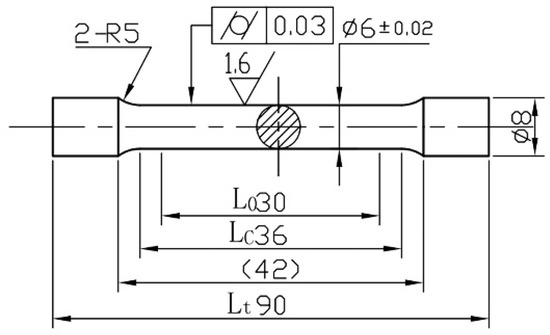
Figure 1.
Sketch of the tensile specimen.
3. Results and Discussion
3.1. Microstructure
Figure 2a,c shows the XRD results of specimens in as-received and solid-solution treated states. Evidently, diffraction peaks of phase are absent after solution treatment. In correspondence with the XRD results, the scanning electron micrograph for a solution state as shown in Figure 2d shows a precipitation-free matrix. Evidently, β-Mg17Al12 precipitates in either a lamellar or rod-like shape that were formed during forging disappeared after solution treatment at 400 °C for 24 h. The precipitates were unstable at a high temperature and then dissolved into a matrix [35,36].
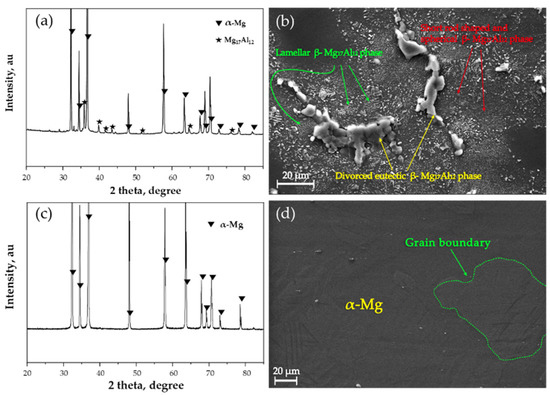
Figure 2.
X-ray diffractograms and scanning electron micrographs of AZ80 magnesium alloys in (a,b) as received and (c,d) solid solution treated states.
Figure 3 presents the XRD results of AZ80 alloys in aged state in different processing conditions. Clearly, additional aging treatment leads to the formation of Mg17Al12 precipitates, and, most likely, more Mg17Al12 formed upon aging at 320 °C than for 150 °C as a result. For each aging temperature, the diffraction peaks of precipitates become intense with prolonging aging time. It can be seen from the SEM observations that the newly formed precipitates were not detectable after aging 150 °C for 2 h (Figure 4a), while a small number of precipitates are present at grain boundaries after 8 h of aging (Figure 4b). The lamellar precipitates developed at the grain boundaries and grew into grain interior, showing a typical morphology for the discontinuous β phase precipitates [37]. The considerable formation of precipitates was observed for an aging time >8 h, and the corresponding area fraction was measured to be ~0.82 vol.%. After aging treatment up to 24 h, the precipitates considerably developed at grain boundaries (Figure 4c). A few blocks were also present in the substrate of 150 °C aged specimen. The content of precipitates were measured to be approximately 12.4 vol.%. When the aging temperature is up to 320 °C, a short-time treatment (Figure 4d) can lead to measurable precipitation (~10.1 vol.%). A higher temperature provides enough driving force for precipitation on aging, which leads to a larger number of precipitates. In addition, the distribution of the precipitates is not uniform. The precipitates developed at grain boundaries show a higher size (~2.96 μm) than that in internal grain (~0.87 μm). As the aging time increased, the number of precipitates was incremental (Figure 4d–f). It was observed that precipitates of ~15.8 vol.% and ~21.2 vol.% form after aging treatment at 320 °C for 8 h and 24 h, respectively. It is likely that the aged specimens present relatively large grains compared to that in a solution state (Figure 4c,f). According to ref. [38], the formation of β-Mg17Al12 precipitates at grain boundaries is associated with the enrichment of the Al solute atom at the grain boundary.
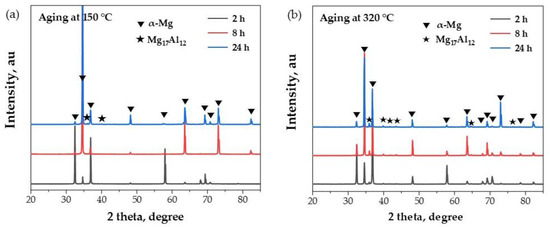
Figure 3.
X-ray diffractograms of AZ80 magnesium alloys aged in different processing conditions: (a) 150 °C, 2~24 h; (b) 320 °C, 2~24 h.
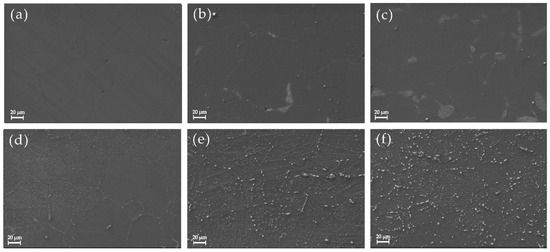
Figure 4.
SEM observations of AZ80 magnesium after aging at 150 °C for (a) 2, (b) 8 and (c) 24 h, and at 320 °C for (d) 2, (e) 8 and (f) 24 h.
Figure 5 shows the highly-magnified SEM images from the aged specimen at 320 °C and 150 °C for 24 h, which further confirms that grain boundaries are the preferential sites for the formation of the precipitates with a typical lamellar structure upon 150 °C aging. For 320 °C aging treatment, the precipitates showing either rod or spherical structure develop throughout the specimen. At the same time, the amount of precipitation for 320 °C aging is significantly higher than at 150 °C. This is consistent with the XRD results in Figure 3. It is pointed out that the continuous precipitation developed from a supersaturated substrate [39,40], suggesting that a pre-solution treatment provides a necessary condition for the occurrence of the continuous precipitation [25].
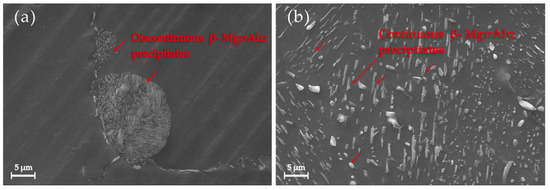
Figure 5.
high magnified SEM observations of AZ80 magnesium after aging at (a) 150 °C for 24 h, and (b) 320 °C for 24 h.
3.2. Mechanical Property
Figure 6 shows the hardness values measured for each processing condition. After solid solution treatment, the hardness of the alloy is approximately 72 HBS. In the research on solution strengthening behavior of the Mg-Al alloy [41], the relationship between hardness and Al content was revealed, and the effect of solution strengthening of the Mg-Al alloy was dependent on the strength of the base. Additional aging leads to a slight increase in hardness. For a relatively short aging duration (≤8 h), a higher aging temperature at 320 °C causes a higher hardness. It should be noted that for a long aging duration, i.e., 24 h, the maximum hardness (~81 HBS) appears when the alloy is subjected to aging at 150 °C, in agreement with the observation in ref. [25]. Evidently, the resulting hardness depends on the volume fraction and morphology of the Mg17Al12 precipitates. Increasing aging duration resulted in coarsening of the precipitates, which thereafter negatively affected the hardness. Additionally, the hardness response could also be related to the difference in grain size between these two aging conditions.
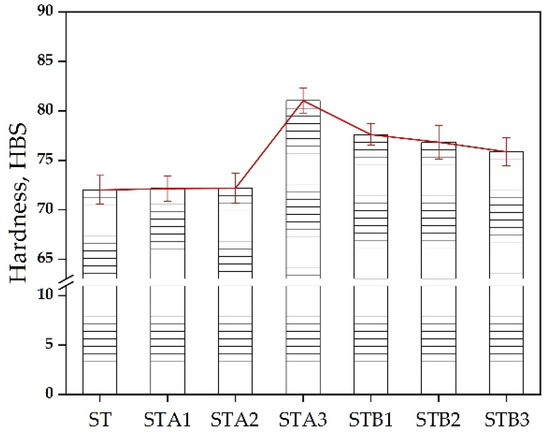
Figure 6.
Hardness for solution treated Mg alloy and aged alloys.
Figure 7 shows the tensile stress–strain curves for extruded AZ80 alloys under various treatments, with the associated mechanical properties given in Table 3. The tensile test for each condition was performed three times to check repeatability, and a representative curve for each test was presented. It is clearly seen that the tensile properties of the alloy show a strong dependence upon the processing conditions. Compared to that of the solution treated state, slightly lower yield and ultimate strengths are obtained for short time aging cases. Long time aging treatment (24 h) leads to an increase in both the yield and ultimate strengths. By comparison, the yield and ultimate strengths are higher in 150 °C aged specimen than 320 °C aged specimen. The 150 °C aged case in particular provides a higher elongation. Evidently, the considerable number of precipitates contributes significantly to the high strength, but results in a compromise on the ductility. An aging treatment at 150 °C can not only enhance the strength of the alloy at room temperature, but also improve the ductility. This is consistent with the previous findings for AZ80 alloy in ref. [42]. In addition, the observed reduction in elongation for a relatively long aging time could be associated with the large volume fraction of precipitates, which would accelerate dislocation pile-up during plastic deformation [43].
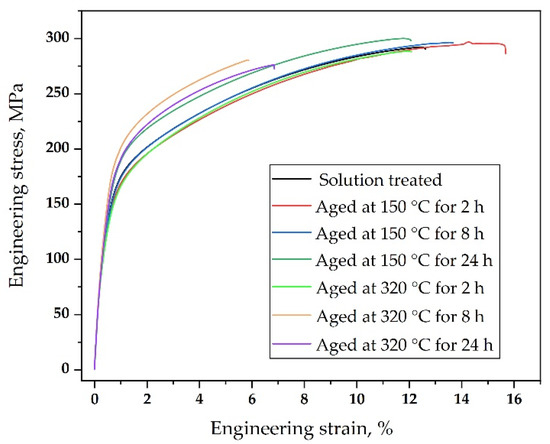
Figure 7.
Engineering stress–strain curves of AZ80 magnesium alloy for different processing conditions.

Table 3.
Tensile properties of extruded AZ80 alloys for different processing conditions.
3.3. Fracture Behavior
Figure 8 shows the tensile fracture morphologies of specimens in different states. As seen in Figure 8a, ductile rupture takes place in the solution-treated condition. SEM fractography in Figure 8a–e indicate a brittle fracture, wherein the quasi-cleavage is the predominant fraction characteristic, i.e., quasi-cleavage steps and tearing ridges. Similarly, mixed features including tearing ridges and the quasi-cleavage can be observed in the fractures of alloys aged at 320 °C (Figure 8f–i). The interface between the second phase and the matrix will crack prematurely when operating under external force, resulting in a degradation in properties. Regarding the aged state at 150 °C, in addition to the brittle fractures, typical ductile fracture features (such as dimples) can also be identified in Figure 8e. This is consistent with the tensile properties, as mentioned in Figure 7.
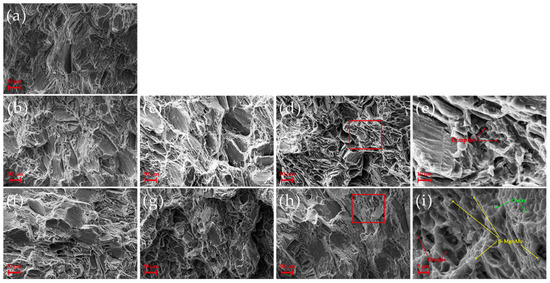
Figure 8.
Observation of fracture in AZ80 magnesium alloys after (a) solution treatment, and after aging at 150 °C for (b) 2 h, (c) 8 h and (d,e) 24 h, and at 320 °C for (f) 2 h, (g) 8 h and (h,i) 24 h. (e,i) are close-up of the region as marked in (d,h), respectively.
The poor match between the β-Mg17Al12 phase and the α-Mg matrix results in an unstable bonding between them. After solution treatment, the precipitates mostly dissolved into the matrix, which greatly reduced the splitting effect on the matrix. Thus, the solution treated AZ80 alloy presents a ductile morphology with excellent plasticity. After aging treatments, the tensile fracture showed brittle fracture characteristics dominated by cleavage. Upon aging at 150 °C, the precipitation developed discontinuously and clustered, and no precipitation formed at the grain boundary. Similar fracture behavior is reported in ref. [44], where the aging treatment was performed at 175 °C for 16 h. After aging at 320 °C, the dispersed β-Mg17Al12 phase was precipitated, resulting in a smaller interface bonding strength and weakening the bonding force between grains, and significantly reducing the plasticity. As shown in Figure 8f–i, owing to the presence of continuous Mg17Al12 phase along the grain boundaries and the brittleness of the β intermetallic compounds, some cracks nucleated and emerged in the β phase. This follows the previous investigation that coarse precipitates can lead to stress concentration and crack initiation, and micro-cracks tend to initiate at the precipitate/matrix interface or in the precipitates [45].
4. Conclusions
Aging treatments to AZ80 magnesium alloys were performed at 150 °C and 320 °C for different durations to investigate the influences on the microstructure and mechanical properties of a AZ80 magnesium alloy. The following conclusions can be drawn.
- (i)
- Upon aging at 150 °C, grain boundaries are favored as sites for the formation of the Mg17Al12 phase, which discontinuously precipitates showing cellular structure. The considerable development of precipitates contributes significantly to hardness.
- (ii)
- Upon aging at 320 °C, Mg17Al12 phase formed throughout the alloy in a spherical or short rod shape is the dominant feature. The occurrence of continuous precipitation results in a slight reduction in ductility of the material.
- (iii)
- Aging treatment leads to relatively higher hardness compared to that of the solution treated alloy. Aging at 150 °C for 24 h is optimal for an increase in both strength and plasticity.
Author Contributions
Conceptualization, Z.X. and L.H.; methodology, M.L.; software, M.L.; validation, Z.Z. and C.L.; formal analysis, L.H.; investigation, Z.X.; resources, Z.X.; data curation, C.L.; writing—original draft preparation, Z.X. and L.H.; writing—review and editing, Z.Z.; visualization, M.L.; supervision, C.L.; project administration, C.L.; funding acquisition, Z.X. All authors have read and agreed to the published version of the manuscript.
Funding
This research received no external funding.
Institutional Review Board Statement
Not applicable.
Informed Consent Statement
Not applicable.
Data Availability Statement
Not applicable.
Conflicts of Interest
The authors declare no conflict of interest.
References
- Das, S.; Graziano, D.; Upadhyayula, V.K.; Masanet, E.; Riddle, M.; Cresko, J. Vehicle lightweighting energy use impacts in US light-duty vehicle fleet. Sustain. Mater. Technol. 2016, 8, 5–13. [Google Scholar]
- Sandlöbes, S.; Friák, M.; Korte-Kerzel, S.; Pei, Z.; Neugebauer, J.; Raabe, D. A rare-earth free magnesium alloy with improved intrinsic ductility. Sci. Rep. 2017, 7, 10458. [Google Scholar] [CrossRef] [PubMed]
- Wang, Q.; Jiang, B.; Chen, D.; Jin, Z.; Zhao, L.; Yang, Q.; Huang, G.; Pan, F. Strategies for enhancing the room temperature stretch formability of magnesium alloy sheet: A review. J. Mater. Sci. 2021, 56, 12965–12998. [Google Scholar] [CrossRef]
- Tan, J.; Ramakrishna, S. Applications of magnesium and its alloys: A review. Appl. Sci. 2021, 11, 6861. [Google Scholar] [CrossRef]
- Wu, M. Microstructure simulation of high pressure die cast magnesium alloy based on modified CA method. Acta Metall. Sin. 2010, 46, 1534–1542. [Google Scholar]
- Paramsothy, M.; Nguyen, Q.B.; Tun, K.S.; Balasubramaniam, R.; Chan, J.; Kwok, R.; Kuma, J.V.M.; Gupta, M. Review of superior mechanical and corrosion properties of wrought magnesium based materials containing nanoparticles. Met. Mater. 2011, 49, 179–187. [Google Scholar] [CrossRef]
- Zhao, X.; Gao, P.; Zhang, Z.; Wang, Q.; Yan, F. Fatigue characteristics of the extruded AZ80 automotive wheel. Int. J. Fatigue 2020, 132, 105393. [Google Scholar] [CrossRef]
- Celotto, S. TEM study of continuous precipitation in Mg–9 wt% Al–1 wt% Zn alloy. Acta Mater. 2000, 48, 1775–1787. [Google Scholar] [CrossRef]
- Mathur, H.; Maier-Kiener, V.; Korte-Kerzel, S. Deformation in the γ-Mg17Al12 phase at 25–278 °C. Acta Mater. 2016, 113, 221–229. [Google Scholar] [CrossRef]
- Bamberger, M.; Dehm, G. Trends in the development of new Mg alloys. Annu. Rev. Mater. Res. 2008, 38, 505–533. [Google Scholar] [CrossRef]
- Asgari, H.; Szpunar, J.; Odeshi, A. Texture evolution and dynamic mechanical behavior of cast AZ magnesium alloys under high strain rate compressive loading. Mater. Des. 2014, 61, 26–34. [Google Scholar] [CrossRef]
- Wang, Y.X.; Fu, J.W.; Yang, Y.S. Effect of Nd addition on microstructures and mechanical properties of AZ80 magnesium alloys. Trans. Nonferr. Met. Soc. China 2012, 22, 1322–1328. [Google Scholar] [CrossRef]
- Wang, Z.; Wang, J.G.; Chen, Z.Y.; Zha, M.; Wang, C.; Liu, S.; Yan, R.F. Effect of Ce addition on modifying the microstructure and achieving a high elongation with a relatively high strength of as-extruded AZ80 magnesium alloy. Mater 2018, 12, 76. [Google Scholar] [CrossRef] [PubMed] [Green Version]
- Wang, Y.X.; Zhou, J.X.; Wang, J.; Luo, T.J.; Yang, Y.S. Effect of Bi addition on microstructures and mechanical properties of AZ80 magnesium alloy. Trans. Nonferr. Met. Soc. China 2011, 21, 711–716. [Google Scholar] [CrossRef]
- Jiang, L.; Zhang, D.; Fan, X.; Guo, F.; Hu, G.; Xue, H.; Pan, F. The effect of Sn addition on aging behavior and mechanical properties of wrought AZ80 magnesium alloy. J. Alloys Compd. 2015, 620, 368–375. [Google Scholar] [CrossRef]
- Xue, H.; Yang, G.; Li, D.; Xing, Z.; Pan, F. Effects of yttrium addition on microstructure and mechanical properties of AZ80–2Sn magnesium alloys. High Temp. Mater. Process. 2015, 34, 743–749. [Google Scholar] [CrossRef]
- Zhao, X.; Li, S.; Zhang, Z.; Gao, P.; Kan, S.; Yan, F. Comparisons of microstructure homogeneity, texture and mechanical properties of AZ80 magnesium alloy fabricated by annular channel angular extrusion and backward extrusion. J. Magnes. Alloy. 2020, 8, 624–639. [Google Scholar] [CrossRef]
- Shahzad, M.; Wagner, L. Influence of extrusion parameters on microstructure and texture developments, and their effects on mechanical properties of the magnesium alloy AZ80. Mater. Sci. Eng. A 2009, 506, 141–147. [Google Scholar] [CrossRef]
- Liao, Q.; Chen, X.; Lan, Q.; Ning, F.; Le, Q. The effect of double extrusion on the microstructure and mechanical properties of AZ80RE alloy. Mater. Res. Express 2018, 5, 126510. [Google Scholar] [CrossRef]
- Zhao, X.; Li, S.; Xue, Y.; Zhang, Z. An investigation on microstructure, texture and mechanical properties of AZ80 Mg alloy processed by annular channel angular extrusion. Materials 2019, 12, 1001. [Google Scholar] [CrossRef] [Green Version]
- Zhao, X.; Li, S.; Yan, F.; Zhang, Z.; Wu, Y. Microstructure evolution and mechanical properties of AZ80 Mg alloy during annular channel angular extrusion process and heat treatment. Materials 2019, 12, 4223. [Google Scholar] [CrossRef] [PubMed] [Green Version]
- Li, Y.; Zhang, Z.M.; Xue, Y. Influence of aging on microstructure and mechanical properties of AZ80 and ZK60 magnesium alloys. Trans. Nonferr. Met. Soc. China 2011, 21, 739–744. [Google Scholar] [CrossRef]
- Zeng, G.; Yu, S.; Gao, Y.; Liu, C.; Han, X. Effects of hot ring rolling and aging treatment on microstructure and mechanical properties of AZ80-Ag alloy. Mater. Sci. Eng. A 2015, 645, 273–279. [Google Scholar] [CrossRef]
- Wu, Y.; Zhang, Z.; Li, B. Effect of aging on the microstructures and mechanical properties of AZ80 and ZK60 wrought magnesium alloys. Sci. Sinter. 2010, 42, 161–168. [Google Scholar] [CrossRef]
- Zhao, D.; Wang, Z.; Zuo, M.; Geng, H. Effects of heat treatment on microstructure and mechanical properties of extruded AZ80 magnesium alloy. Mater. Des. 2014, 56, 589–593. [Google Scholar] [CrossRef]
- Chalay-Amoly, A.; Zarei-Hanzaki, A.; Changizian, P.; Fatemi-Varzaneh, S.; Maghsoudi, M. An investigation into the microstructure/strain pattern relationship in backward extruded AZ91 magnesium alloy. Mater. Des. 2013, 47, 820–827. [Google Scholar] [CrossRef]
- Wang, H.Y.; Yu, Z.P.; Zhang, L.; Liu, C.G.; Zha, M.; Wang, C.; Jiang, Q.C. Achieving high strength and high ductility in magnesium alloy using hard-plate rolling (HPR) process. Sci. Rep. 2015, 5, 17100. [Google Scholar] [CrossRef] [Green Version]
- Li, J.Y.; Xie, J.X.; Jin, J.B.; Wang, Z.X. Microstructural evolution of AZ91 magnesium alloy during extrusion and heat treatment. Trans. Nonferr. Met. Soc. China 2012, 22, 1028–1034. [Google Scholar] [CrossRef]
- Duly, D.; Cheynet, M.; Brechet, Y. Morphology and chemical nanoanalysis of discontinuous precipitation in Mg-Al alloys—I. Regular growth. Acta Metall. Et Mater. 1994, 42, 3843–3854. [Google Scholar] [CrossRef]
- Duly, D.; Cheynet, M.; Brechet, Y. Morphology and chemical nanoanalysis of discontinuous precipitation in Mg-Al allyos—II. Irregular growth. Acta Metall. Et Mater. 1994, 42, 3855–3863. [Google Scholar] [CrossRef]
- Duly, D.; Brechet, Y. Nucleation mechanism of discontinuous precipitation in Mg-Al alloys and relation with the morphology. Acta Metall. Et Mater. 1994, 42, 3035–3043. [Google Scholar] [CrossRef]
- Zhang, M.X.; Kelly, P. Crystallography of Mg17Al12 precipitates in AZ91D alloy. Scr. Mater. 2003, 48, 647–652. [Google Scholar] [CrossRef]
- Liu, Y.; Zhou, J.; Zhao, D.; Tang, S. Investigation of the crystallographic orientations of the β-Mg17Al12 precipitates in an Mg-Al-Zn-Sn alloy. Mater. Charact. 2016, 118, 481–485. [Google Scholar] [CrossRef]
- Daud, Z.C.; Azahar, S.H.; Derman, M.N.; Adzali, N.M.S.; Zaidi, N.H.A.; Adnan, S.A. The effect of aging time on microstructure and hardness value of AZ80 Mg Alloy. In IOP Conference Series: Materials Science and Engineering; IOP Publishing: Bristol, UK, 2020; Volume 957, p. 012051. [Google Scholar]
- Prakash, P.; Toscano, D.; Shaha, S.K.; Wells, M.A.; Jahed, H.; Williams, B.W. Effect of temperature on the hot deformation behavior of AZ80 magnesium alloy. Mater. Sci. Eng. A 2020, 794, 139923. [Google Scholar] [CrossRef]
- Shi, R. Nonisothermal dissolution kinetics on Mg17Al12 intermetallic in Mg-Al alloys. J. Magnes. Alloy. 2021. [Google Scholar] [CrossRef]
- Li, Y.; Chen, Y.; Cui, H.; Xiong, B.; Zhang, J. Microstructure and mechanical properties of spray-formed AZ91 magnesium alloy. Mater. Charact. 2009, 60, 240–245. [Google Scholar] [CrossRef]
- Yakubtsov, I.A.; Diak, B.J.; Sager, C.A.; Bhattacharya, B.; MacDonald, W.D.; Niewczas, M. Effects of heat treatment on microstructure and tensile deformation of Mg AZ80 alloy at room temperature. Mater. Sci. Eng. A 2008, 496, 247–255. [Google Scholar] [CrossRef]
- Celotto, S.; Bastow, T.J. Study of precipitation in aged binary Mg-Al and ternary Mg-Al-Zn alloys using 27Al NMR spectroscopy. Acta Mater. 2001, 49, 41–51. [Google Scholar] [CrossRef]
- Braszczyńska-Malik, K.N. Discontinuous and continuous precipitation in magnesium-aluminium type alloys. J. Alloys Compd. 2009, 477, 870–876. [Google Scholar] [CrossRef]
- Cáceres, C.H.; Rovera, D.M. Solid solution strengthening in concentrated Mg–Al alloys. J. Light Met. 2001, 1, 151–156. [Google Scholar] [CrossRef]
- Tolouie, E.; Jamaati, R. Effect of β-Mg17Al12 phase on microstructure, texture and mechanical properties of AZ91 alloy processed by asymmetric hot rolling. Mater. Sci. Eng. A 2018, 738, 81–89. [Google Scholar] [CrossRef]
- Jung, J.G.; Park, S.H.; You, B.S. Effect of aging prior to extrusion on the microstructure and mechanical properties of Mg-7Sn-1Al-1Zn alloy. J. Alloys Compd. 2015, 627, 324–332. [Google Scholar] [CrossRef]
- Tan, M.; Liu, Z.; Quan, G. Effects of hot extrusion and heat treatment on mechanical properties and microstructures of AZ91 magnesium alloy. Energy Procedia 2012, 16, 457–460. [Google Scholar] [CrossRef] [Green Version]
- Jing, S.; Dingfei, Z.; Tian, T.; Daliang, Y.; Junyao, X.; Fusheng, P. Effect of aging treatment before extrusion on microstructure and mechanical properties of AZ80 magnesium alloy. Rare Met. Mater. Eng. 2017, 46, 1768–1774. [Google Scholar] [CrossRef] [Green Version]
Publisher’s Note: MDPI stays neutral with regard to jurisdictional claims in published maps and institutional affiliations. |
© 2022 by the authors. Licensee MDPI, Basel, Switzerland. This article is an open access article distributed under the terms and conditions of the Creative Commons Attribution (CC BY) license (https://creativecommons.org/licenses/by/4.0/).